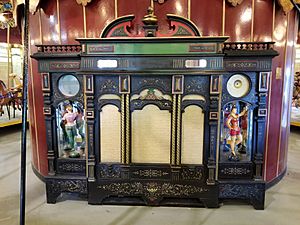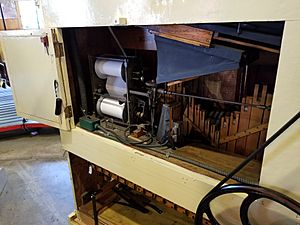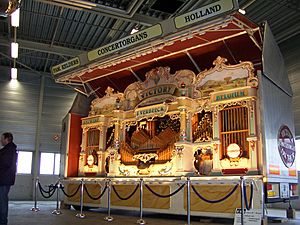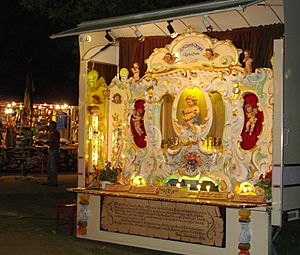Fairground organ facts for kids

A fairground organ is a special kind of pipe organ. It's built to play loud music at fairgrounds and on merry-go-rounds. Unlike organs used indoors, these are made to be heard over noisy crowds and the sounds of fairground rides. They create a big, exciting sound!
A Look Back: The History of Fairground Organs
As fairgrounds grew and added more machines in the late 1800s, they needed louder music. Fairground organs became very popular from the 1880s until the 1920s. This was before electric sound systems became common.
These organs were not just musical instruments. They were also beautiful attractions themselves! Their cases were often very fancy and decorated. They sometimes had moving figures, like a conductor whose arm moved with the music. Other figures might strike bells or play instruments like a Glockenspiel. These moving parts added to the fun and visual show.
Fairground organs were designed to play the popular songs of the time. They could sound like a whole human band. That's why in the United States, they are often called band organs.
Most fairground organs work by using air pressure. This air comes from bellows, which are like big pumps, located at the bottom of the instrument. These organs usually don't have keyboards. Instead, they play music automatically.
The music is stored in different ways:
- On a spinning barrel with pins, similar to a music box.
- On long strips of cardboard cards with holes, called book music.
- On rolls of paper with holes, called music rolls.
For example, the "Victory" organ you see pictured above uses traditional book music. But it also has a modern computer connection! This allows it to play music electronically. Its owner can even link it to other organs so they all play the same song perfectly together.
Fairground organs were used in many places. You could find them on rides, at special shows like old-time movie theaters (bioscopes), and in other parts of amusement parks, like ice rinks. The companies that made fairground organs also often built instruments for indoor dance halls, called dance organs, and smaller ones for street performers, called street organs.
Just like cars or phones, fairground organs come in many sizes and styles. Each manufacturer had its own special features. Today, many people love to collect and restore these old instruments. New fairground organs and music are still being made!
How Fairground Organs Work

Early fairground organs were made to be small and easy to use. They could be operated by anyone, or even fully automatically. These organs used a spinning barrel with pins to play music. If you wanted new songs, you had to get a whole new barrel!
Later, a company from Paris called Gavioli introduced a better system. They used strong, interchangeable cardboard "book music" with holes punched in it. This system became very popular because it was cheaper and easier to update the music. Many other manufacturers started using it too.
Another way music was stored was on paper rolls. These rolls were smaller and cheaper to make than book music. While paper rolls could be damaged more easily, all systems would wear out over time from repeated playing.
Both "book" and "roll" systems worked by reading the holes. This was done using air pressure, suction, or mechanical parts. To make the cardboard book music last longer, it was often coated with a special resin called shellac. Music rolls were usually made from strong, moisture-resistant paper.
Almost all parts of a fairground organ work automatically from the music media. On larger organs, the music can even control different sound effects, lights, and the moving figures!
Images for kids




